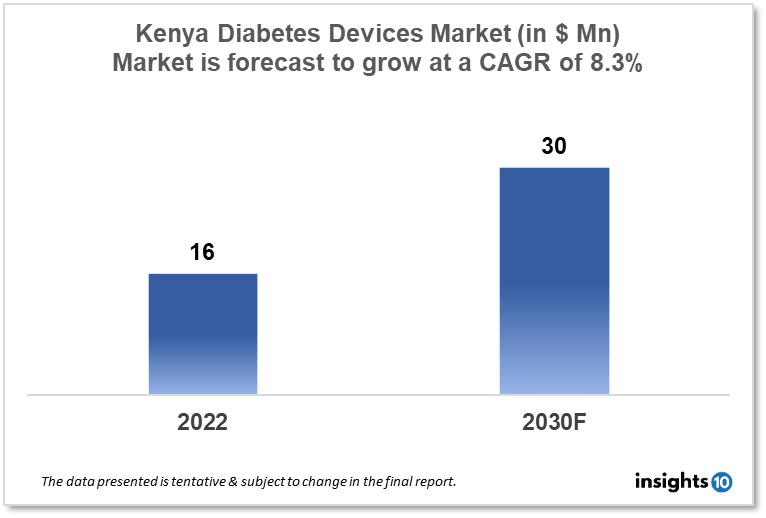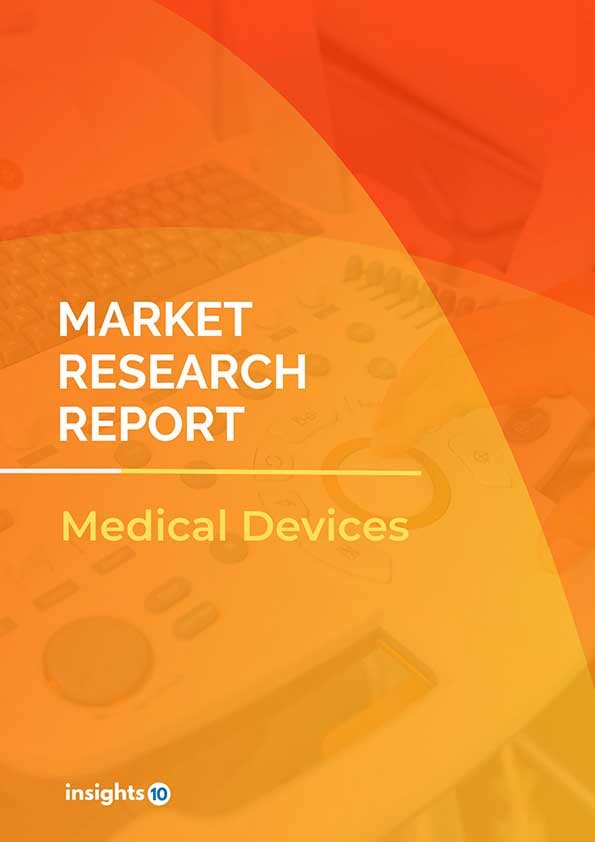Kenya Diabetes Devices Market Analysis
Kenya's Diabetes Devices Market is expected to witness growth from $16 Mn in 2022 to $30 Mn in 2030 with a CAGR of 8.30 % for the forecasted year 2022-2030. The main factors behind Kenya's increasing healthcare costs are the country's expanding population and the government's focus on improving healthcare facilities. This increased spending is likely to increase demand for diabetes devices. The market is segmented by type and by the end user. Some key players in this market include Kijenzi, APICALMED, Johnson & Johnson, Philipps Healthcare, Medtronic, Roche and Dexcom.
Buy Now

Kenya Diabetes Devices Healthcare Market Executive Analysis
Kenya's Diabetes Devices Market is expected to witness growth from $16 Mn in 2022 to $30 Mn in 2030 with a CAGR of 8.30 % for the forecasted year 2022-30. Kenya incurred costs for healthcare totalling $2,743 million. That is the same as 7% of the nation's GDP. Our ongoing medical expenses are paid for by families directly (32%), our government (31%), and our taxes (31%). Donor gifts come in second, with a sizable 26% share. In Kenya, health insurance makes up a pitiful 13% of total health spending.
In Kenya, 2.1% of adults (20-79 years) had diabetes in 2021. This equates to roughly 700,000 adult Kenyans who have diabetes. In Kenya, there were 1,600 fatalities brought on by diabetes in 2021. By 2045, the prevalence of diabetes in Kenya is expected to increase to 2.6%, representing an anticipated 1.3 million adult diabetics. Additionally, a sizable portion of diabetes cases in Kenya go undiagnosed; it is believed that 42.4% of adults with diabetes are unaware of their illness. This emphasises the significance of screening and early identification programmes to assist in identifying and managing diabetes in Kenya. People with diabetes in Kenya are able to benefit from and use diabetes devices in a variety of ways. They can assist people in better controlling their condition, lowering the chance of complications, and enhancing their general standard of life. The expense and availability of these devices, however, can restrict access, so initiatives to widen access to these devices and educational programs should take precedence.

Market Dynamics
Market Growth Drivers
The main factors behind Kenya's increasing healthcare costs are the country's expanding population and the government's focus on improving healthcare facilities. This increased spending is likely to increase demand for diabetes devices as more people become aware of how important it is to effectively manage their diabetes. Insulin pumps and continuous glucose monitoring systems are just a couple of the new and improved diabetes devices that manufacturers are continuously developing. Due to these technological developments, there will probably be a rise in the demand for diabetes devices in Kenya, particularly among those who want more cutting-edge and useful devices.
Market Restraints
In Kenya, many diabetes devices, including insulin pumps and continuous glucose monitoring systems, can be pricey, rendering them inaccessible to many Kenyans who might not be able to afford them. Because of their high price, these devices are in lower demand, which can restrain market development.
Competitive Landscape
Key Players
- Kijenzi (KE)
- APICALMED (KE)
- Johnson & Johnson
- DarioHealth
- Medtronic
- Philipps Healthcare
- Dexcom
Recent Notable Deals
2022: In order to improve diabetes care in Kenya, Sanofi Kenya, a pharmaceutical business, merged forces with Access Afya, a Kenyan healthcare organization, in 2022. In Kenya's underserved communities, the partnership seeks to offer affordable diabetes treatment, including diabetes devices and medications.
Healthcare Policies and Regulatory Landscape
The Pharmacy and Poisons Board (PPB), the Kenya Bureau of Standards (KEBS), and the Ministry of Health (MOH) are just a few of the government organisations that keep an eye on the healthcare laws and regulations in Kenya's market for diabetes devices. Diabetes devices must be registered with the PPB and are subject to Kenyan law. Before they can be sold in the nation, diabetes devices are required by the PPB to go through a rigorous registration procedure that includes testing, evaluation, and approval. Prior to going on sale to the general public, the registration procedure is meant to make sure that diabetes devices adhere to a set of safety and quality requirements. The creation and enforcement of guidelines for diabetes devices is the responsibility of the KEBS. Prior to being approved for use in Kenya, the KEBS guarantees that diabetes devices meet a number of requirements, including safety, quality, and performance standards. To make sure that producers of medical devices adhere to these standards, the KEBS also performs checks and audits.
1. Executive Summary
1.1 Device Overview
1.2 Global Scenario
1.3 Country Overview
1.4 Healthcare Scenario in Country
1.5 Regulatory Landscape for Medical Device
1.6 Health Insurance Coverage in Country
1.7 Type of Medical Device
1.8 Recent Developments in the Country
2. Market Size and Forecasting
2.1 Market Size (With Excel and Methodology)
2.2 Market Segmentation (Check all Segments in Segmentation Section)
3. Market Dynamics
3.1 Market Drivers
3.2 Market Restraints
4. Competitive Landscape
4.1 Major Market Share
4.2 Key Company Profile (Check all Companies in the Summary Section)
4.2.1 Company
4.2.1.1 Overview
4.2.1.2 Product Applications and Services
4.2.1.3 Recent Developments
4.2.1.4 Partnerships Ecosystem
4.2.1.5 Financials (Based on Availability)
5. Reimbursement Scenario
5.1 Reimbursement Regulation
5.2 Reimbursement Process for Diagnosis
5.3 Reimbursement Process for Treatment
6. Methodology and Scope
Diabetes Devices Market Segmentation
By Type (Revenue, USD Billion):
The market is divided into blood glucose monitoring systems, insulin delivery systems, and mobile applications for managing diabetes within the type segment. Due to its convenience, ease of use, and usefulness in providing patients and healthcare professionals with real-time insights regarding diabetic conditions for integrated diabetes management, the segment for diabetes management mobile applications is anticipated to grow at the highest rate during the forecast period. Bare-metal Stents
- Blood glucose monitoring systems
- Self-monitoring blood glucose monitoring systems
- Continuous glucose monitoring systems
- Test strips/Test papers
- Lancets/Lancing Devices
- Insulin delivery Devices
- Insulin pumps
- Insulin pens
- Insulin syringes and needles
- Diabetes management mobile applications
By End User (Revenue, USD Billion):
The diabetes market is divided into hospitals & specialty clinics and self & home care, based on the end user.
- Hospitals & Specialty Clinics
- Self & Home Care
Insights10 will provide you with the reports within 10 key parameters which are:
- Market Overview
- Market Growth Drivers & Restraints
- Epidemiology of Disease Type
- Market Segmentation
- Market Share
- Competitive Landscape
- Key Company Profiles
- Healthcare Policies & Regulatory Framework
- Reimbursement Scenario
- Factors Driving Future Growth
Based on our many years of experience, we believe that these are the parameters that are critical to decision-making for business stakeholders. Our focused approach to developing reports focused on 10 key parameters, enabled us to arrive at the name “Insights10”.

Stage I: Market Data Collection
Primary Interviews: We have developed a network of experts, freelancers, and researchers across countries through which we engage with local experts to gather key data points and assumptions about each market. We also engage regularly with some of the best market research agencies such as Atheneum, GuidePoint, GLG, etc. to conduct surveys and interviews, and build intelligence. We have language translators as a part of our team, who between them can cover 30+ languages allowing us to extract better local insights.
Secondary Data Collection: We have developed strong expertise and experience in secondary data collection methods for developing unique data sets and research material. We gather data from multiple reliable sources to maintain a high level of accuracy and consistency. The market data is analyzed and forecasted using appropriate statistical and coherent models. The report offers an overall analysis of the market size, growth, and market share as well as a segment-level analysis of the specific market. Our report includes precise, to-the-point information related to the overall market, competition, growth drivers, challenges, regulatory updates, and competition.
Data Sources: We have access to multiple highly reliable free and subscription data sources. We have many years of experience to understand which sources are more dependable for what and which to prefer for the reliable and latest information. The key sources of information include the following, but are not limited to:

Stage II: Market Data Analysis and Statistical Model
Market Trends: We generally look at macro parameters and micro indicators. The macro parameters include changes in government policies, demand and supply of the market, government intervention programs, and major market share. The micro indicators are GDP growth, market size, market volume, etc. We also understand nuances specific to each country like the US, Canada, India, Germany, etc., and have worked across 60+ countries and hence not only understand global trends but how these differ by country, how payment models, market structure, cultural parameters, etc. differ in each country.
Market Sizing and Analysis: Our expert data analytics team has created various market forecast models by employing the top-down approach i.e. starting with the large overall market and segmenting different areas and the bottom-up approach i.e. starting with population and epidemiology and rolling up based on spend, etc., estimating the size of the market, and distributing among the geographic and/or product segments.
The top-down approach is mainly used for new product forecasting and the bottom-up approach is used for demand estimation of any product for different countries summed up to form the total market. We are able to round off insights and build stronger forecasts because we always do both these methods and triangulate the final numbers.
The study on the market covers the analysis of the leading geographies such as Asia-Pacific, Africa, Europe, Middle East, North America, and Latin America for the period of 2022 to 2030. The qualitative analysis covers the industry landscape and trends, market opportunities, competitive landscape, and policy and regulatory scenario, and the quantitative analysis covers different market estimates and forecasts.
Data Triangulation & Validation:
Data triangulation of various sources and results of the research are carried out by benchmarking with reliable sources such as industry statistics, statistical databases, and company-level averages, etc.
We make sure to finalize the numbers in alignment with the market research. Firstly, our internal experts ensure thorough validation and checking to ensure accurate and precise analysis and then validation is also done using a multiple-data analysis model. Two-level validation is done and entails the finalization of the report scope and the way of representation pattern.
(1).png)
Stage III: Interpretation and Presentation
Analysis & Interpretation: The information gathered is then analyzed and synthesized. The second series of interviews are done if necessary to check and validate. The future opportunities are analyzed by understanding product commercialization and many other factors. It also comprises the analysis of data discrepancies observed across various data sources. Information procured from secondary and primary results is then, interpreted by considering the following parameters: (a partial list)
- Establishing market drivers and trends
- Analyzing the regulatory landscape to understand future growth
- Market Segment based analysis to obtain revenue/volume
- Analyzing current needs and determining penetration to estimate the market
Insights: Our reports deliver actionable insights backed with supporting facts and figures to assist you in achieving exemplary growth. Our in-depth analyses are interspersed with relevant insights and statistics to offer an executive-level view of a given market. The description helps in correlating many minor factors affecting the market and their impact on the different segments within the market.
Data curated from the analysis and interpretation are drawn to portray all in one consolidated report.
Presentation & Reporting: The market research report is presented in different forms such as charts by using a scientific approach for easy understanding. Historic, current, and future analysis is provided for each market in terms of both value and volume. The size of the market is interpreted in the US Dollar value and the respective unit, based on the product, for volume consumption.
The foreign exchange rates are calculated on the respective dates and for the respective regions covered in the study.
To request a free sample copy of this report, please complete the form below.
We value your inquiry and offer free customization with every report to fulfil your exact research needs.
This report addresses
- Intelligent insights to take informed business decisions
- Qualitative, acute and result oriented market analysis
- Market size and forecasts from 2022 to 2030
- Opportunities for expansion and in-depth market analysis
- Segmentation and regional revenue forecasts
- Analysis of the market share and competitive landscape
- Strategic Recommendations to chart future course of action
- Comprehensive Market Research Report in PDF and PPT formats
Need more?
- Ask our analyst how this study was put together to learn more
- Discuss additional requirements as part of the free customisation
- Add more countries or regions to the scope
- Get answers to specific business questions
- Develop the business case to launch the product
- Find out how this report may influence your business revenue







































